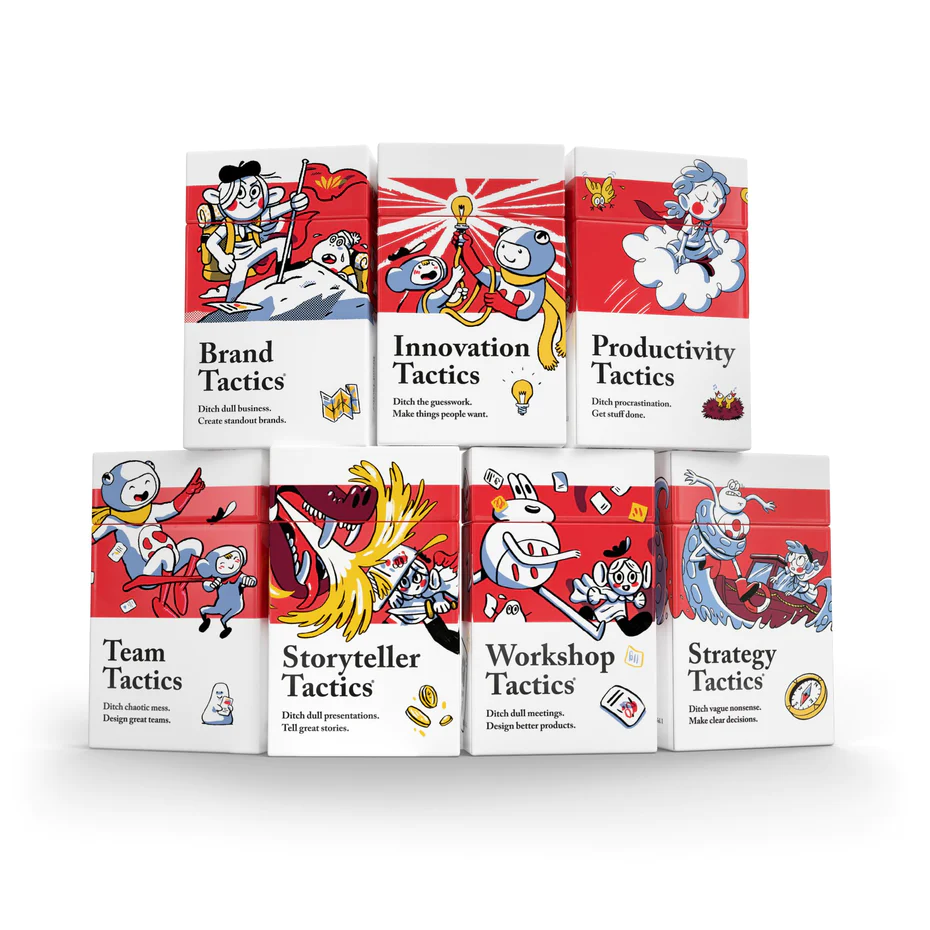Brand Tactics Deck
Get to know the Pip Decks Solution to Identifying Opportunity and Developing Brands: the Brand Tactics Deck
The Brand Tactics deck by Pip Decks provides 54 cards with recipes and processes to clarify the scope and goals of their brand, align messaging with audience beliefs, establish REAL differentiation, and discover new ways to imagine their brand’s position in the market. With 54 actionable recipe cards, your team will have the steps it needs to create and maintain a vital brand.
Want to get the Brand Tactics deck right away? Grab yours with a 15% discount by using our Affiliate Link.
The Brand Tactics Deck by Pip Decks – How To Build Your Brand
What is a brand?
As Marty Neumeier famously wrote in his book The Brand Gap, “A brand is not what you say it is, it’s what THEY say it is.” While this statement was profound to many people when they read it for the first time, this understanding did not immediately help brand managers and business founders identify real steps they can take to shape and improve their brand.
To move brand building from ‘understandable’ to ‘actionable,’ today we have the Brand Tactics deck by Pip Decks.
The Brand Tactics Deck is a powerful tool for anyone trying to make their mark on the world.
The deck is built to develop and refine your brand through a flexible structure that provides the right “recipe” at the right time to take your brand to the next level.
What do you get with the Brand Tactics deck complete package?
- a “brand building system” to identify insights and make them actionable within your unique brand position
- “recipes,” that put you in the right frame to discover insights and take action (differentiate, discover, transform, execute and expand)
- “strategy” – techniques develop your pathway to unique, valuable solutions
- “keep on truckin’” – tools to create a processes that keeps your brand vital and current with audiences
- “iconic leaps” – vision to establish an identity that stands above and beyond the fray
- a digital set of cards you can use in presentations or add to your device so you’ve got the tools at your fingertips
- an online portal with video based trainings on each and every tactic in the deck
Develop your brand with the Brand Tactics deck
Brand Tactics Deck Objectives
Author and brand Consultant Alex M H Smith writes that “unlike many writers on ‘brand’, he sees it as a whole business endeavor.” We heartily agree. Brand isn’t something to ‘tack on’ through the communications team, nor is it something to outsource. In evaluating the deck, it is clear that the primary objective is to make ‘brand’ an accessible part of the company to every employee, and to make creating big leaps creative and fun! The deck allows much flexibility regarding which parts of brand building are held close to the leadership team and which are disbursed for broad input and collaboration.
Whether a company has done a lot of work on its brand, very little, or even if the business is just starting to develop a sense of itself as a brand, the Brand Tactics deck takes big ideas and clarifies the steps to make brand building and brand innovation manageable and engaging.
Brand Tactics Deck Structure
The deck is structured into categories including context, introspection, strategy, judgment, execution, double down, and recipes. By solving brand challenges through the processes outlined in the deck, business owners, nonprofit boards, and purveyors of influence gain access to the levers that close the gap between what WE think our brand is and what THEY think it is. Beyond that, it helps to clarify what you do, how it’s similar or different from others, what you say about your products, services, and ideas, how you expand beyond your current offerings, and how you evolve with customers as the market grows and changes.
Brand Tactics Deck Solutions
There are many powerful solutions in this deck, but one of our favorites has to do with storytelling and language.
Brand Storytelling and Brand Language
Brands have to communicate with their audiences authentically. In business communications, language can become muddied and stiff. Brand Tactics cards like “Pub Language” and “Ditch the Deck” help you think about how you’d explain what you do and clarify the meaning behind it to your mates at the pub. Maybe it’s not a pub, but a restaurant or a book club – but you get the idea.
“Ditch the Deck” encourages leaders to get away from the ubiquitous ‘pitch deck’ and write out their brand story in paragraph form. By structuring what would ordinarily be ‘pitched’ to investors, buyers, distributors, or partners as an essay or short story, it’s easy to see where the gaps and unbelievable leaps come in.
To build a ‘brand’ you’ve got to get away from ‘accountability metrics’ and ‘EBITDA’ and ‘knowing your numbers’ and all the other lingo that goes with the business territory. The solution is to get to the language of your audience in order to build the language and voice of your brand in a way that can be heard and understood, and, ultimately, that is relatable.
Brand Differentiation
Creating a standout brand that can resist both commodification and intrusion by competitors is the gold standard. This challenge is addressed in a number of cards in the Brand Tactics deck. Recipes like “Category Cliches” and “So You Think You Are Special?” help you identify and avoid falling into common product categories, routine thinking, and at the same time, falsely perceiving your company as different or unique. The Brand Tactics cards like “The Real Product” help you clarify the differences between the [product/service/idea] features, who is served, and how they are served.
The foundation for differentiation, as described by the recipes in the deck, is to clarify what a unique demographic wants or needs, and to match the real offer to that, then to clarify the value.
Brand Testing
Another solution in the Brand Tactics deck is to test the viability and validity of brand ideas, branded products, and branded services. The Brand Tactics cards “The Challenger Trap” and “Opposites Game” help to evaluate if an idea is truly salient with an audience AND unique. In the Challenger Trap, the idea is to identify the traits of your product versus the competitor’s. By creating a grid of traits, you are able to see, if you are truthful in your self-assessment, how close or distant you and your competitors are from one another.
The “Opposites Game” helps brands determine if their offering is unique enough and viable enough to hold water. By determining if the opposite of your strategy is viable, you can determine if yours is too. The reality behind this activity is that meaningful offerings exist on a continuum of value, so the opposite of a sound brand strategy can also be viable, simply for a different audience than yours.
Brand Testing helps organizations test to see if the brand addresses an appropriate niche within the larger market.
Brand Management
Once a brand has been differentiated and offers truly unique products and services that are aligned with the brand’s audience, an organization can move on to managing their brand. The Brand Tactics deck supports Brand Management with cards like, “Power Platform” and “Creative Canvas” provide processes for distilling the main message and then painting the world with your message. With the latter card you’ll identify each touch point in your business and identify if and how it should become a unique feature in your brand delivery system.
An important part of managing an established brand is creating unique, consistent messaging across all of your touch points. The Brand Tactics card “Copy Playbook” presents a recipe for creating the statements that act as the foundation of your written communications. From an endline, through value statements and on to your brand manifesto, this simple recipe has a lot packed inside.
Brand Growth
But what about “brand growth,” you say. The deck has solutions for that as well. The Brand Tactics deck supports brand growth and expansion with recipes like “Paper Boss,” a card focused on transferring authority from founders and leaders to the brand itself. The idea is that leaders learn from customers, audiences and the team to shape the brand, then the brand shapes and influences everything else. By following the brand, the team has a framework for evaluating opinions about priorities and next steps.
The card “Hamster Wheel” helps teams evaluate what needs to be repeated over and over to maintain the same market space and audience, and what needs to change. “Brand Stretch” allows your team to think about other spaces the brand might represent itself such as events, causes, communities and more.
Brand Tactics Synopsis
When businesses start to shift from an “operations” or “selling” mindset to a brand mindset they’ve got some things to overcome. First, the products and sales team become responsive to the brand. Designers, communicators, managers and leaders have to ask themselves. “Do these features really represent the brand and fulfill customer and audience expectations?”
The Brand Tactics deck includes the creative thinking processes necessary to move teams to a brand mindset, shape their business through ‘brand,’ and go places they’ve never gone before. Interested in digging into the details? Get yours, and a 15% discount with our affiliate link.
We wanted to learn everything we could about brand storytelling. This is what we found out…
Build a Brand Multiverse
We wanted to learn everything we could about brand storytelling. After learning how DC and Marvel maintain their brands this is what we found out…
Get to know Pip Decks
Meet all of the decks in the Pip Decks line and get the tools to innovate, create strategy, tell better stories, and develop powerful teams.



